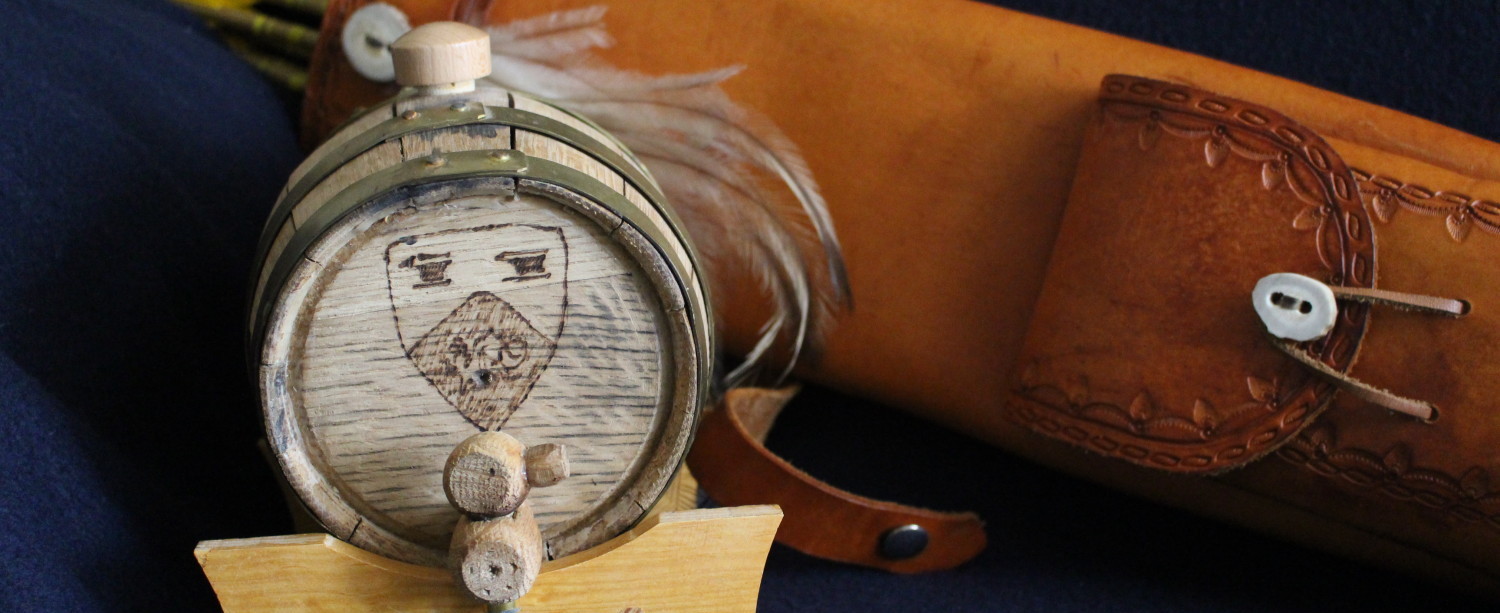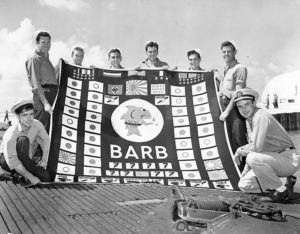The Sub That Sank a Train – In Their Own Words
This is my second installment of my series, “In Their Own Words” wherein I use quotes from WWII submarine reports to highlight themes of commanders that I find interesting. My introductory post in this series focused on a couple of themes: Commanders’ candor and/or colorful descriptions and Issues associated with life on the vessel. This installment falls into the former of those themes as I highlight some of the comments of Eugene B. Fluckey (sometimes referred to as “Lucky Fluckey”). Fluckey commanded the USS Barb (SS-220), a Gato-class sub that was commissioned in July of 1942, for 5 war patrols. A 1935 graduate of the Naval Academy, he was awarded the Congressional Medal of Honor, four Navy Crosses, two Distinguished Service Medals, and two Legion of Merit awards.
Fluckey proved himself to be a resourceful commander who had a knack for developing innovative tactics to fight the Japanese, including the first sub commander to request and receive a rocket launcher for this boat. Much has been written about Fluckey in addition to his own book published in 1997 entitled, Thunder Below. I won’t add to that body of literature here. Instead, I will highlight some of Fluckey’s more colorful descriptions of the “sinking” of a train. He describes this event in his book, but for some reason, his official report is much more descriptive and colorful.
Essentially, Fluckey decided that sinking ships was a worthy goal, but that destroying the “middle man” that delivered the goods to the ships would be a reasonable strategy. So, in July of 1945, with no torpedoes remaining, Fluckey planned a daring commando raid to destroy a train and the tracks it ran on. The raid would take place just on shore at Patience Bay, Sakhalin Island in the southern Sea of Okhotsk.
Fluckey’s choice of commandos for this raid involved several criteria. He wanted at least one person with knowledge of wiring a trigger mechanism (extra points if this person knew something about trains). He wanted men from a variety of ratings on the sub. He wanted half to be regular Navy and half to be Naval Reserve. He also wanted some crew who had been Boy Scouts because they would have special survival skills. Finally, he wanted unmarried men, but it turns out that the leader of the raid was married.
The eight crewmen who participated in the “raid” were:
- Chief Gunners Mate Paul G. Saunders, USN
- Electricians Mate 3rd Class Billy R. Hatfield, USNR
- Signalman 2nd Class Francis Neal Sever, USNR
- Ships Cook 1st Class Lawrence W. Newland, USN
- Torpedomans Mate 3rd Class Edward W. Klingesmith, USNR
- Motor Machinists Mate 2nd Class James E. Richard, USN
- Motor Machinists Mate 1st Class John Markuson, USN
- Lieutenant William M. Walker, USNR
Fluckey really wanted to go on the raid, but that was out of the question. The Barb had picked up a Japanese prisoner earlier in the patrol. Dubbed, “Kamikaze”, he also begged Fluckey to go with the raiders just in case they needed someone to translate.
So, at midnight, July 24, 1945, with only two fathoms of water beneath the keel, the Barb held steady at 950 yards off shore. The eight saboteurs loaded their gear into two rafts and headed for shore. As Fluckey reports in his formal report:
…had planned to say something apropos to such an operation such as “Synchronize your watches” however all I could think of was – “Boys, if you get stuck, head for Siberia 130 miles north – follow the mountain ranges, good luck.”
The plan was to plant the Barb‘s 55lb scuttling charge under the rails of the track and install a pressure switch. Each saboteur had his own task to perform. Bird calls were to be used for communication (Bob White and Whippoorwill). At least one of the men worried that the calls might actually attract attention because they might not be species native to this area!
Fluckey went on in his report to describe the details of the operation, some of which are quite amusing. Due to some faulty navigation…
…when the party landed, they found themselves in somebody’s back yard 50 yards from a house. Fortunately, no dogs put in an appearance, though dog tracks with human barefoot prints alongside were noticed on the beach
The team skirted around the house…
At this point, what had appeared to be grass, from our offshore view, turned out to be waist-high bullrushes (sic) which crunched and crackled with every move, shrieking out their presence. All shapes took on human forms.
They came to a highway.
All clear, so Lt. Walker arose starting a dash across the road and immediately fell head-first into a four-foot ditch. Picking himself up, he cautioned the rest to watch out for the ditch, then made a dash across the highway and immediately fell headfirst into the ditch on the other side.
They saw a structure a ways down the track and sent Markuson to investigate. They also found what appeared to be a suitable place to position the explosive charge. Digging began but was soon interrupted by someone running up the track. It was Markuson who found a sleeping Japanese soldier in the structure that turned out to be a guard tower. His fellow saboteurs almost shot him because he did not give the appropriate bird whistle.
When queried as why he didn’t give the alert to warn them of his approach he replied, “I tried to whistle, but when I saw that tower my mouth dried up!
Digging continued. The team had been using improvised tools manufactured on the boat, but after a while
They were laid aside and excavation continued dog fashion. A flickering light was spotted down the tracks. A train? Work ceased. In proper frontier fashion all ears were pinned to the rails. No sound. Turn to again.
Suddenly, at an estimated range of 75 to 100 yards a train loomed up roaring down upon them. Nearly the entire party made a dive for the nearest foxhole, the few remaining squeezed themselves into hiding behind bushes six inches high and two inches wide. The train passed with the engineer hanging far out of his cab looking each of the party over personally.
When the initial foxhole crash dive was made, Hatfield, the electrician, landed in such a fashion that both carbon dioxide cartridges attached to his lifejacket went off. He was sure he was shot yet soon found that he was merely approaching maternity as his Mae West inflated.
The charge was planted and the switch placed in what was hoped to be the optimal distance from the rail to set off the explosion. Fluckey finished his commentary.
Circuits were checked, the charge was hooked up, the digging disguised then the night filled with whippoorwills. A little difficulty was encountered in launching the boats through the light surf with everyone getting a bit soaked. About two-thirds of the way back, they sighted the train and thoroughly enjoyed the fruits of their effort being explosively plucked.
In a more detailed description of the saboteur’s return to the sub Fluckey provided the following in his chronological account:
0132 At last the boats are leaving the beach. Muffled cheers from our side. They are blinking our signal – holding off our answer. Their blinking becoming insistent – perhaps they mistake us for a patrol vessel. Gave them a short dash and darkness settled.
0145 Ye Gods! another northbound train coming up the tracks. Broke the silence to yell to the boats, “Paddle like the devil!.” Entirely wasted, the boats have spotted the train and the paddles are churning like eggbeaters. The train is getting closer and closer. Any second now. What a moment! Even the boats have stopped to look. Everyone is awe stricken with the expectancy of momentary destruction.
0147 WHAM! What a thrill! What a beautiful sight! The charge made a much greater explosion than we expected, the engine boilers blew, wreckage flew two hundred feet into the air in a flash of flame and smoke cars piled up and rolled off the track in a writhing, twisting mass of wreckage. Cheers!
That’s the story of the sub that sank a train. Lt. Walker earned a Navy Cross for his actions in the sabotage of the train. The other seven crew members were awarded Silver Stars. The war ended just weeks after this daring action. Eugene B. Fluckey went on the attain the rank of Rear Admiral. He died on June 28, 2007 at the age of 93. He will always be remembered as a most innovative and aggressive submariner and the commander who ordered the sinking of a train.
If you would like to read several pages from Fluckey’s official war patrol report from which the above quotes came, click here.


Hello,
I stumbled across your blog site while searching images taken aboard subs in the Pacific in WW2. The story about the Barb’s skipper and his attack on a Japanese train was entertaining! I’m a former navy man (signalman) and find stories about the daring exploits of submariners fascinating. I never served aboard a sub ( visited the USS Skate in Guam while on deployment) but it amazes me how ordinary sailors were assigned to missions that today would involve advanced training (SEALS, MARSOC, DELTA…?). When I discovered your interest in Deck Logs done in verse, I recalled my own time aboard the USS Callaghan writing my entry in that form…anything to get through an otherwise boring Quarterdeck Watch! I get to share these stories with my students now. Good stuff!!
Greetings, Stewart!
Thanks for your service and your comments on the blog! I agree with you regarding submarine service. I’ve spent hundreds of hours poring through war patrol reports and I never cease to be amazed at the conditions those guys experienced on WWII era subs.
Dave